Mapping Ecosystem Services in an Andean Water Supply Basin
Abstract
1. Introduction
2. Study Area
3. Materials and Methods
3.1. Implementation of the SWAT Model
3.1.1. Inputs
- Digital elevation model (DEM): for topography, the study used a DEM with 12.5 m accuracy (cell size 12.5 × 12.5), obtained from the Alaska Satellite Facility website; the LPRB has an altitudinal gradient from 1980 to 3820 m.a.s.l.
- Land use map: the map contains information of the areas and landcover types present in LPRB. It was generated for April 2017 (low percentage of clouds) using images of the Sentinel 2A satellite platform, with 10 m precision, considering the Corine Land Cover methodology, adapted in Colombia and the algorithm developed by WP4 RICCLISA [28], identifying 14 landcover types from levels 1, 2, and 3. Field visits and key stakeholders’ workshops validated this information (social cartography).
- Weather database: the database was generated from information available of daily precipitation data from nearby weather stations, for the period from 1 January 1999 to 31 December 2017. The statistical weather data required by the SWAT model are the multi-annual averages of maximum and minimum temperature and precipitation, standard deviation for each month, bias coefficient for daily precipitation, number of days of precipitation, probabilities of a humid day after a dry-humid day. These were calculated through the mathematical expressions suggested in the SWAT manual [27].
- Soil type map: contains information of the physical and chemical properties of the LPRB (scale 1:25.000), obtained from information on the study of soils by the planning and management document for LPRB [29].
3.1.2. Model Set Up
- Delineating the basin and sub-basins: The flow direction and the accumulation of water within the sub-basins was simulated with the inputs: DEM, mask of the study area, and the river network, as well as the definition of slope’s range and the maximum and minimum elevations. Outlets were selected considering the main drains of the LPRB.
- Creation and definition of the hydrologic response units (HRUs): The HRUs map was based on the superposition of the shapefiles soil types (22 units), land use (12 types), and the specific slopes range (four ranges). From this output, a minimum percentage of aggregation was chosen by expert criteria, considering representative land use, soils, and slopes of the zone, allowing the prioritization of the HRUs, using 1% for LULC, 6% as minimum value for types of soils, and 10% for range of slope, with the lowest loss of information over an area of the basin and the best distribution in the sub-basins [27].
- Weather generator and tables of meteorological data: Information was included based on the weather station identifiers and location of Arrayanales (ARR) and Diviso (DIV) stations daily precipitation database (mm) and its statistical data. Due to the lack of information in the study area, SWAT model was used to simulate and complete input values of solar radiation, relative humidity, and wind speed.
3.1.3. Calibration and Validation
3.2. Evaluation of the Ecosystem Services Supply
3.2.1. Identification of WES
3.2.2. Prioritized Ecosystem Services for LPRB
3.2.3. Social Cartography
3.3. Analysis of Ecosystem Services Distribution
Socioecological Conflicts
4. Results
4.1. Implementation of the SWAT Model
4.2. Updated Outputs of the SWAT Modelling of LPRB
4.3. SWAT Calibration and Validation
4.4. Evaluation of the ES Supply
4.5. Identification of WES
4.6. Prioritized Ecosystem Services for LPRB
4.7. Social Cartography
4.8. Sociecological Conflicts
5. Discussion
5.1. Implementation of the SWAT Model
5.2. Evaluation of the ES Supply
5.3. Analysis of ES Distribution
6. Conclusions
Author Contributions
Funding
Institutional Review Board Statement
Informed Consent Statement
Data Availability Statement
Acknowledgments
Conflicts of Interest
References
- González, R.B. Apertura y reprimarización de la economía colombiana. Nueva Soc. 2011, 231, 46–65. [Google Scholar]
- Vergara, W.V. Reforma agraria en Colombia y ‘Prosperidad para Todos’: El camino hacia el desarrollo humano. Rev. Univ. Salle 2011, 54, 87–109. [Google Scholar]
- IDEAM. Estudio Nacional del Agua; Ministro de Ambiente y Desarrollo Sostenible: Bogota, Colombia, 2018. [Google Scholar]
- Berrouet, L.; Villegas-Palacio, C.; Botero, V. Vulnerability of Rural Communities to Change in an Ecosystem Service Provision: Surface water supply. A Case Study in the Northern Andes, Colombia. Land Use Policy 2020, 97, 104737. [Google Scholar] [CrossRef]
- Ruiz, D.; Moreno, H.A.; Gutiérrez, M.E.; Zapata, P.A. Changing climate and endangered high mountain ecosystems in Colombia. Sci. Total Environ. 2008, 398, 122–132. Available online: http://www.sciencedirect.com/science/article/B6V78-4SBRTJ2-5/2/1dfd957a2f5d7a1c6b4a7cdbec927661 (accessed on 15 September 2018). [CrossRef]
- van der Hammen, T. Diagnóstico, cambio global y conservación. In Congreso Mundial de Páramos; Ministerio de Medio Ambiente: Paipa, Colombia, 2002; Volume 1, pp. 60–71. [Google Scholar]
- Buytaert, W.; Iñiguez, V.; de Bièvre, B. The effects of afforestation and cultivation on water yield in the Andean páramo. Ecol. Manag. 2007, 251, 22–30. Available online: http://www.sciencedirect.com/science/article/B6T6X-4P9K8T4-2/2/6325e25837319cc9affcb748d21a719a (accessed on 1 April 2019). [CrossRef]
- Harden, C. Human impacts on headwater fluvial systems in the northern and central Andes. Geomorphology 2006, 79, 249–263. [Google Scholar] [CrossRef]
- Buytaert, W.; Cuesta, F.; Tobón, C. Potential impacts of climate change on the environmental services of humid tropical alpine regions. Glob. Ecol. Biogeogr. 2011, 20, 19–33. [Google Scholar] [CrossRef]
- Crespo, P.; Célleri, R.; Buytaert, W.; Feyen, J.; Iñiguez, V.; Borja, P.; De Bièvre, B. Land use change impacts on the hydrology of wet Andean páramo ecosystems. Status Perspect. Hydrol. Small Basins 2010, 336, 71–76. [Google Scholar]
- Shen, Z.; Qiu, J.; Hong, Q.; Chen, L. Simulation of spatial and temporal distributions of non-point source pollution load in the Three Gorges Reservoir Region. Sci. Total Environ. 2014, 493, 138–146. [Google Scholar] [CrossRef]
- Francesconi, W.; Srinivasan, R.; Pérez-Miñana, E.; Willcock, S.P.; Quintero, M. Using the Soil and Water Assessment Tool (SWAT) to model ecosystem services: A systematic review. J. Hydrol. 2016, 535, 625–636. [Google Scholar] [CrossRef]
- Rincón-Ruiz, A.; Arias-Arévalo, P.; Hernández, J.M.N.; Cotler, H.; Caso, M.A.; Meli, P.; Tauro, A.; Akerberg, V.D.Á.; Avila-Foucat, V.S.; Cardenas, J.P.; et al. Applying integrated valuation of ecosystem services in Latin America: Insights from 21 case studies. Ecosyst. Serv. 2019, 36, 100901. [Google Scholar] [CrossRef]
- Hoyos, N.; Correa-Metrio, A.; Jepsen, S.M.; Wemple, B.; Valencia, S.; Marsik, M.; Doria, R.; Escobar, J.; Restrepo, J.C.; Velez, M.I. Modeling Streamflow Response to Persistent Drought in a Coastal Tropical Mountainous Watershed, Sierra Nevada De Santa Marta, Colombia. Water 2019, 11, 94. [Google Scholar] [CrossRef]
- Lehmann, A.; Timoner, P.; Fasel, M.; Lacayo, M.; Vaghefi, S.A.; Abbaspour, K.C. SWATCH21: A project for linking eco-hydrologic processes and services to aquatic biodiversity at river and catchment levels. Ecohydrol. Hydrobiol. 2019, 19, 182–197. [Google Scholar] [CrossRef]
- Glavan, M.; Pintar, M.; Urbanc, J. Spatial variation of crop rotations and their impacts on provisioning ecosystem services on the river Drava alluvial plain. Sustain. Water Qual. Ecol. 2015, 5, 31–48. [Google Scholar] [CrossRef]
- Uribe, N.; Srinivasan, R.; Corzo, G.; Arango, D.; Solomatine, D. Spatio-temporal critical source area patterns of runoff pollution from agricultural practices in the Colombian Andes. Ecol. Eng. 2020, 149, 105810. [Google Scholar] [CrossRef]
- Rajaei, F.; Dahmardeh Behrooz, R.; Ahmadisharaf, E.; Galalizadeh, S.; Dudic, B.; Spalevic, V.; Novicevic, R. Application of Integrated Watershed Management Measures to Minimize the Land Use Change Impacts. Water 2021, 13, 2039. [Google Scholar] [CrossRef]
- Villamizar, S.R.; Pineda, S.M.; Carrillo, G.A. The Effects of Land Use and Climate Change on the Water Yield of a Watershed in Colombia. Water 2019, 11, 285. [Google Scholar] [CrossRef]
- Mera-Parra, C.; Oñate-Valdivieso, F.; Massa-Sánchez, P.; Ochoa-Cueva, P. Establishment of the Baseline for the IWRM in the Ecuadorian Andean Basins: Land Use Change, Water Recharge, Meteorological Forecast and Hydrological Modeling. Land 2021, 10, 513. [Google Scholar] [CrossRef]
- Wei, X.; Garcia-Chevesich, P.; Alejo, F.; García, V.; Martínez, G.; Daneshvar, F.; Bowling, L.C.; Gonzáles, E.; Krahenbuhl, R.; McCray, J.E. Hydrologic Analysis of an Intensively Irrigated Area in Southern Peru Using a Crop-Field Scale Framework. Water 2021, 13, 318. [Google Scholar] [CrossRef]
- Bennett, D.E.; Gosnell, H. Integrating multiple perspectives on payments for ecosystem services through a social–ecological systems framework. Ecol. Econ. 2015, 116, 172–181. [Google Scholar] [CrossRef]
- Clerici, N.; Cote, N.F.; Escobedo, F.J.; Rubiano, K.; Villegas, J.C. Spatio-temporal and cumulative effects of land use-land cover and climate change on two ecosystem services in the Colombian Andes. Sci. Total Environ. 2019, 685, 1181–1192. [Google Scholar] [CrossRef] [PubMed]
- Uribe, N.; Corzo, G.; Quintero, M.; van Griensven, A.; Solomatine, D. Impact of conservation tillage on nitrogen and phosphorus runoff losses in a potato crop system in Fuquene watershed, Colombia. Agric. Water Manag. 2018, 209, 62–72. [Google Scholar] [CrossRef]
- Ortegón, Y.A.C.; Acosta-Prado, J.C.; Castellanos, P.M.A. Impact of Land Cover Changes on the Availability of Water Resources in the Regional Natural Park Serranía de Las Quinchas. Sustainability 2022, 14, 3237. [Google Scholar] [CrossRef]
- Ruiz, D.M.; Martínez, J.P.; Otero, J.D.; Figueroa, A. Effects of productive activities on the water quality for human consumption in an Andean basin, a case study. Rev. Int. Contam. Ambient. 2017, 33, 361–375. [Google Scholar] [CrossRef]
- Arnold, J.G.; Moriasi, D.N.; Gassman, P.W.; Abbaspour, K.C.; White, M.J.; Srinivasan, R.; Santhi, C.; Harmel, R.D.; Van Griensven, A.; Van Liew, M.W.; et al. SWAT: Model use, calibration, and validation. Trans. ASABE 2012, 55, 1491–1508. [Google Scholar] [CrossRef]
- Pencué, E.L.; Solano, Y.T.; Corrales, J.C.; Figueroa, A. A Semi-Supervised Hybrid Approach for Multitemporal Multi-Region Multisensor Landsat Data Classification. IEEE J. Sel. Top. Appl. Earth Obs. Remote Sens. 2016, 9, 5424–5435. [Google Scholar] [CrossRef]
- CRC. Plan de Ordenación y Manejo de la Subcuenca Hidrográfica del Río Las Piedras (Actualización) Resolucion 0751/2006. F. P. R. L. Piedras. Popayán, CRC: 457; CRC: Boca Raton, FL, USA, 2006. [Google Scholar]
- Kumar, N.; Singh, S.K.; Srivastava, P.K.; Narsimlu, B. SWAT Model calibration and uncertainty analysis for streamflow prediction of the Tons River Basin, India, using Sequential Uncertainty Fitting (SUFI-2) algorithm. Model. Earth Syst. Environ. 2017, 3, 30. [Google Scholar] [CrossRef]
- IGAC. Estudio General de Suelos y Zonificación de Tierras Departamento del Cauca; Instituto Geografico Agustin Codazzi: Bogota, Colombia, 2009; Volume 2, p. 86. [Google Scholar]
- Ruíz, D.; Maysels, R.; Muñoz, F.F.; Díaz, E. Water Security Hub. In Social Cartography Participatory Workshops; GCRF-UKRI: Newcastle, UK; Available online: https://www.watersecurityhub.org/rmgc/social-cartography-participatory-workshops-qualitative-digital-methods-module (accessed on 27 November 2022).
- Mejia, L.R. Manejo Adaptativo del Territorio en una Cuenca Altoandina Desde la Diversidad Cultural y Ecosistémica. Ph.D. Thesis, de Doctorado en Ciencias Ambientales. Universidad del Cauca, Popayán, Colombia, 2017. [Google Scholar]
- Santhi, C.; Arnold, J.G.; Williams, J.R.; Dugas, W.A.; Srinivasan, R.; Hauck, L.M. Vadidation of the SWAT model on a large RWER basin with point and nonpoint sources 1. JAWRA J. Am. Water Resour. Assoc. 2001, 37, 1169–1188. [Google Scholar] [CrossRef]
- Jin, G.; Deng, X.; Hasan, S.S.; Zhao, C.; Gibson, J. Hydrological Ecosystem Services for Integrated Water Resources Management. Ecohydrology 2018, 361–386. [Google Scholar] [CrossRef]
- Kenward, R.E.; Whittingham, M.J.; Arampatzis, S.; Manos, B.D.; Hahn, T.; Terry, A.; Simoncini, R.; Alcorn, J.; Bastian, O.; Donlan, M.; et al. Identifying governance strategies that effectively support ecosystem services, resource sustainability, and biodiversity. Proc. Natl. Acad. Sci. USA 2011, 108, 5308–5312. [Google Scholar] [CrossRef]
- Caro-Camargo, C.A.; Velandia-Tarazona, J.E. The effect of changes in vegetation cover on the hydrological response of the sub-basin Los Pozos. Dyna 2019, 86, 182–191. [Google Scholar] [CrossRef]
- Campaz, G.; Enríquez, J. Simulación de Caudales en la Subcuenca Río Las Piedras Mediante la Aplicación del Modelo Hidrológico SWAT; Universidad del Cauca: Popayán, Colombia, 2012. [Google Scholar]

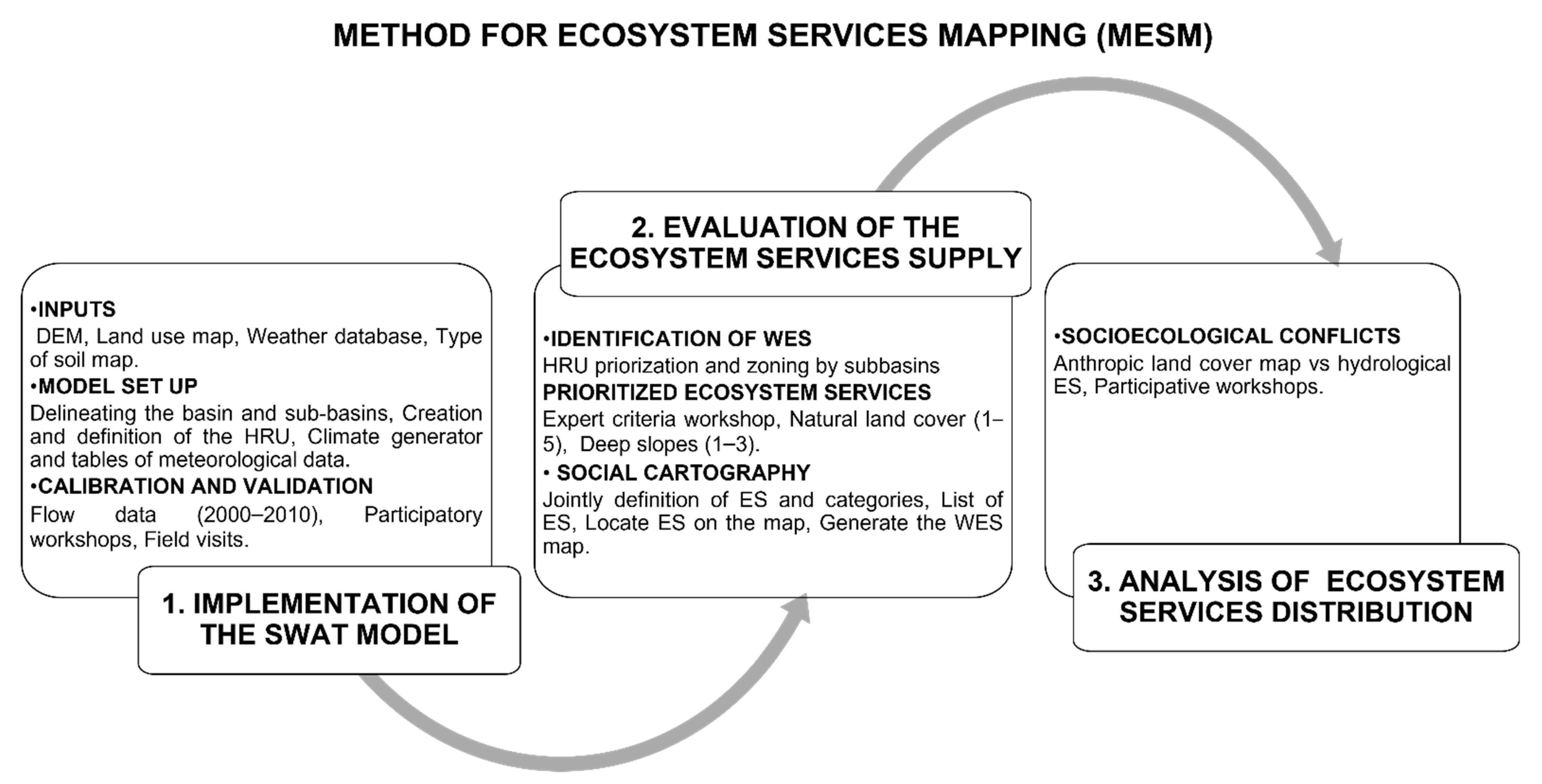
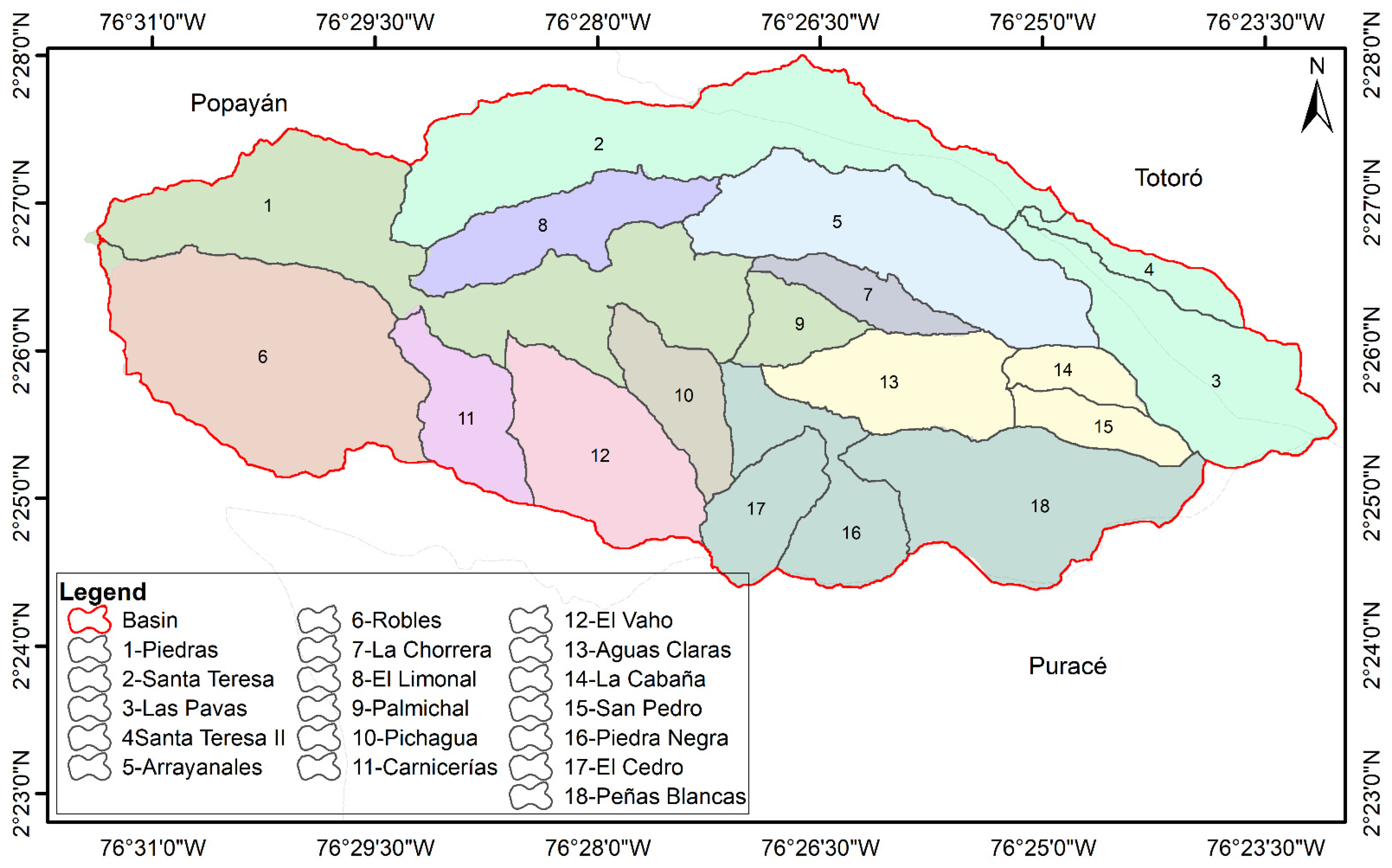

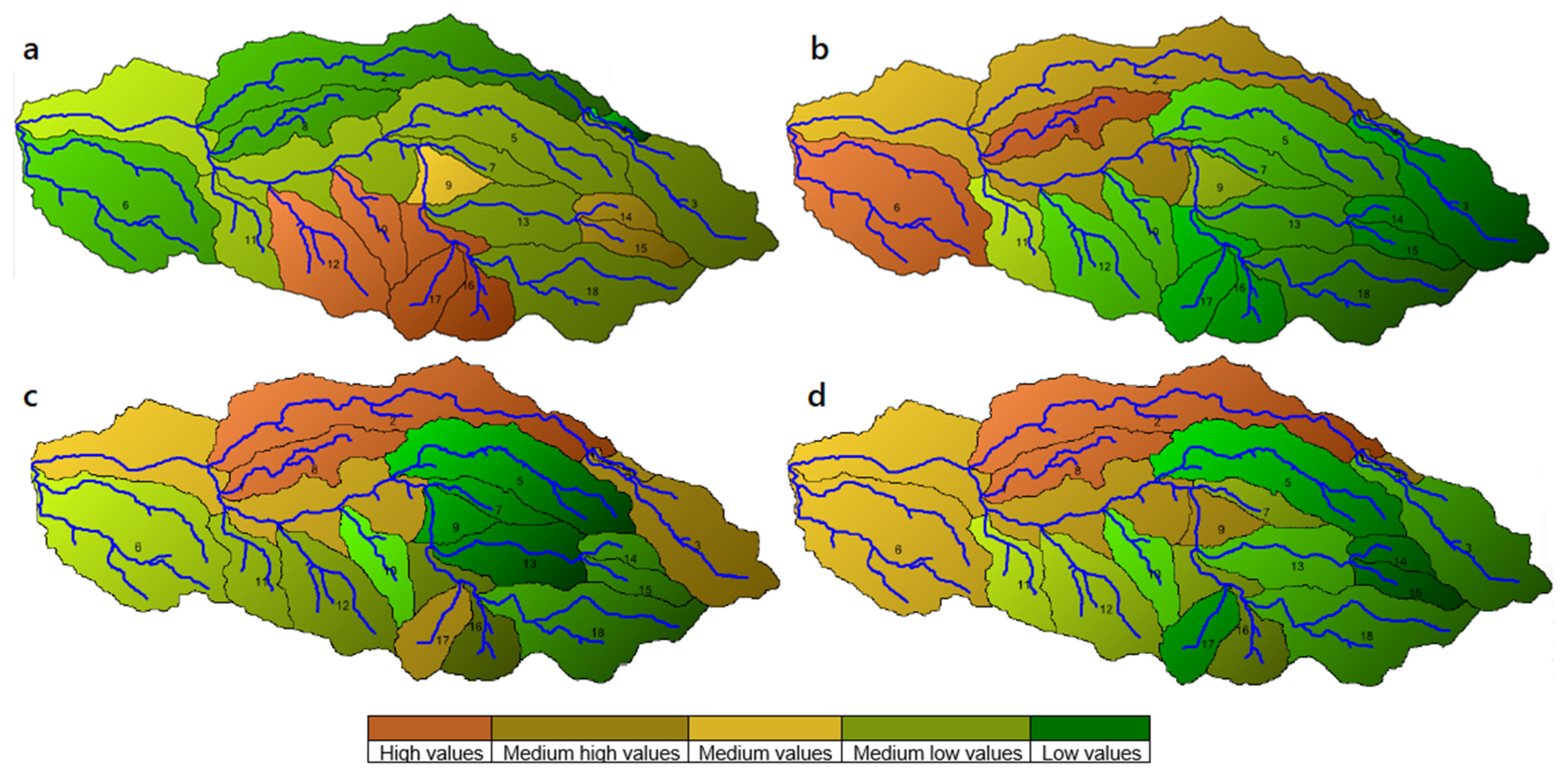
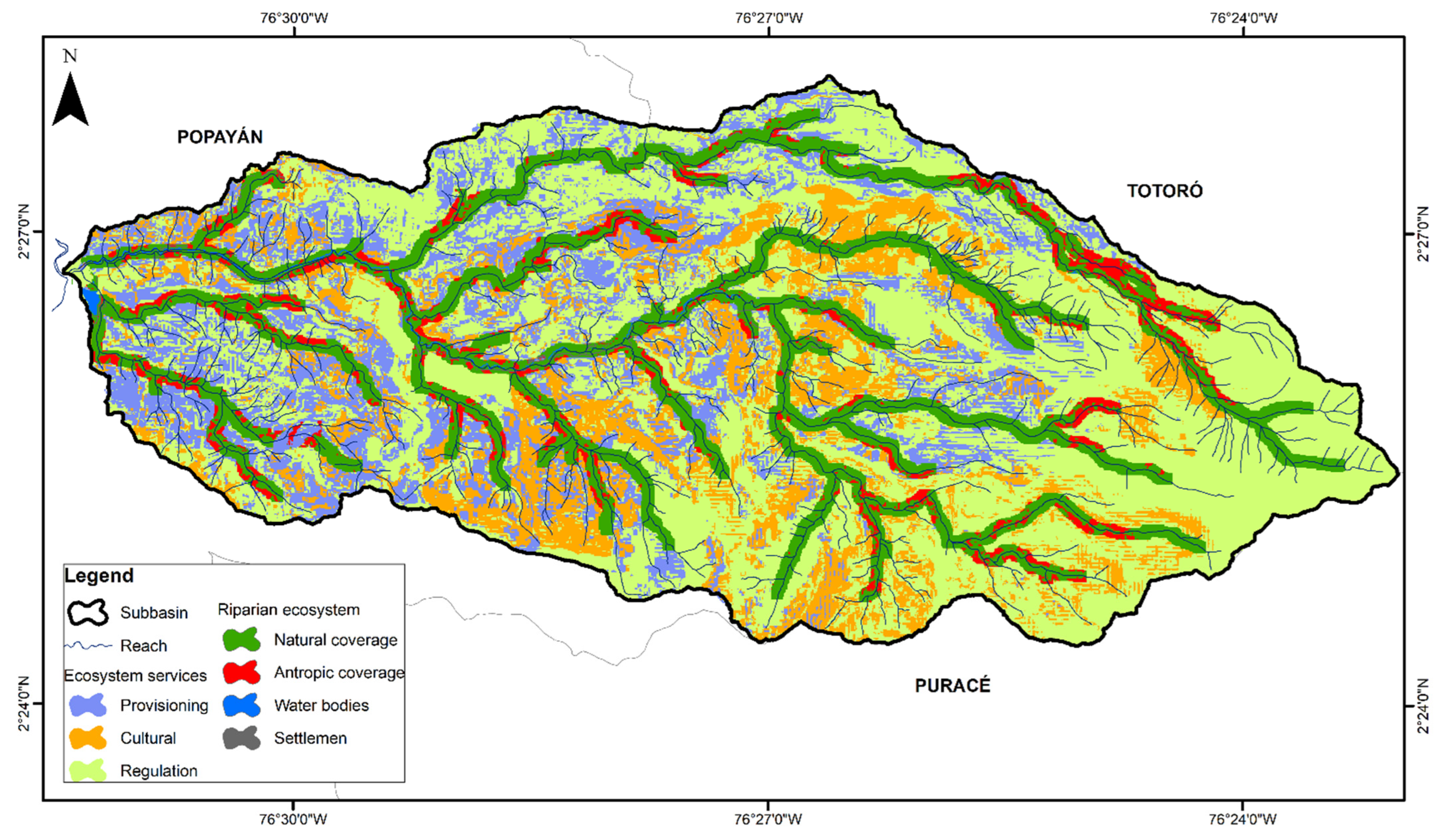
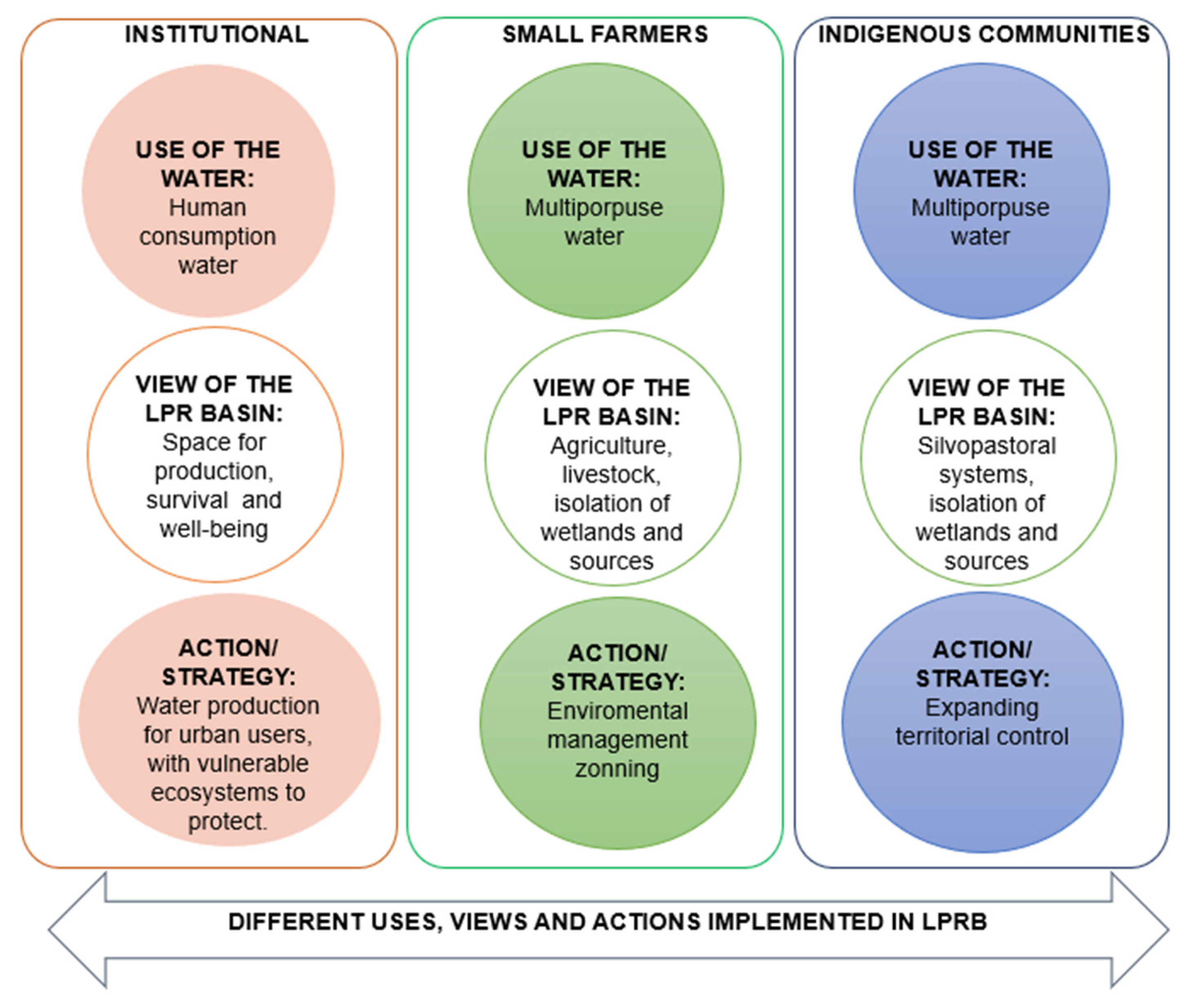
| ID | Parameter | Description | Process | Initial Range | Calibrated Value |
|---|---|---|---|---|---|
| 1 | GWQMN (Threshold water depth in the shallow aquifer for flow) | Threshold of water depth | Base flow | 550–1000 | 862.96 |
| 2 | Alpha-Bf (Base flow alpha factor) | Base flow factor | Base flow | 0–1 | 0.5 |
| 3 | Gw-Delay (Groundwater delay) | Storage of groundwater | Base flow | 0–50 | 26.86 |
| 4 | Cn2 (Initial SCS CN II value) | Run-off | 35–98 | 45.63 |
| ES CATEGORY | PRIORITIZED ES | ||
|---|---|---|---|
| Upper | Middle | Lower | |
| Provisioning |
|
|
|
| Regulating |
|
|
|
| Cultural |
|
|
|
Disclaimer/Publisher’s Note: The statements, opinions and data contained in all publications are solely those of the individual author(s) and contributor(s) and not of MDPI and/or the editor(s). MDPI and/or the editor(s) disclaim responsibility for any injury to people or property resulting from any ideas, methods, instructions or products referred to in the content. |
© 2023 by the authors. Licensee MDPI, Basel, Switzerland. This article is an open access article distributed under the terms and conditions of the Creative Commons Attribution (CC BY) license (https://creativecommons.org/licenses/by/4.0/).
Share and Cite
Ruíz Ordoñez, D.M.; Camacho De Angulo, Y.V.; Pencué Fierro, E.L.; Figueroa Casas, A. Mapping Ecosystem Services in an Andean Water Supply Basin. Sustainability 2023, 15, 1793. https://doi.org/10.3390/su15031793
Ruíz Ordoñez DM, Camacho De Angulo YV, Pencué Fierro EL, Figueroa Casas A. Mapping Ecosystem Services in an Andean Water Supply Basin. Sustainability. 2023; 15(3):1793. https://doi.org/10.3390/su15031793
Chicago/Turabian StyleRuíz Ordoñez, Diana Marcela, Yineth Viviana Camacho De Angulo, Edgar Leonairo Pencué Fierro, and Apolinar Figueroa Casas. 2023. "Mapping Ecosystem Services in an Andean Water Supply Basin" Sustainability 15, no. 3: 1793. https://doi.org/10.3390/su15031793
APA StyleRuíz Ordoñez, D. M., Camacho De Angulo, Y. V., Pencué Fierro, E. L., & Figueroa Casas, A. (2023). Mapping Ecosystem Services in an Andean Water Supply Basin. Sustainability, 15(3), 1793. https://doi.org/10.3390/su15031793






